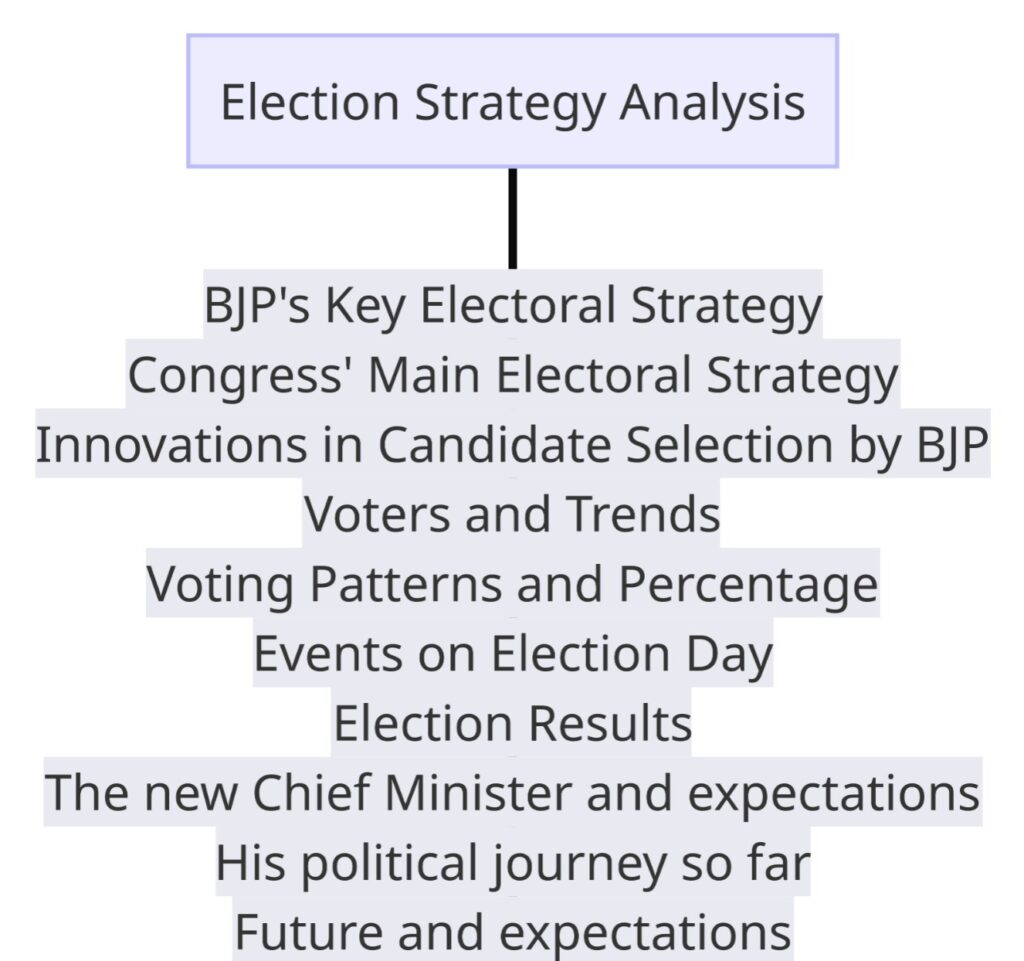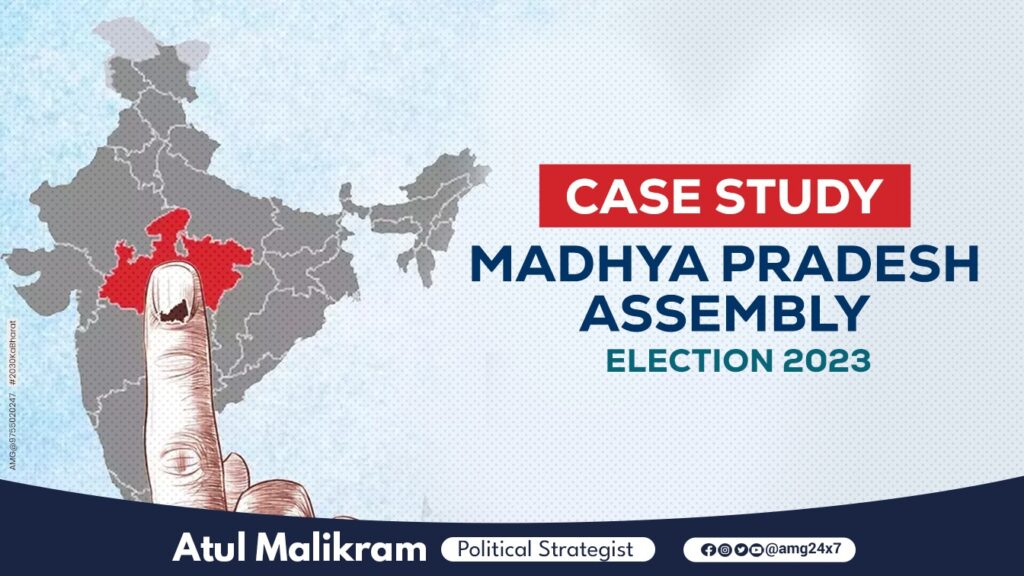The electoral dynamics in the Madhya Pradesh Assembly elections of 2023 underwent significant transformations. The voting process, conducted on November 17 in the 230-member state assembly, concluded with the announcement of results on December 3. The outcome, though surprising to many, demonstrated noteworthy shifts not only in voting patterns but also across the political spectrum, from grassroots levels to local establishments.
Expectations were set high, with exit polls on news channels and certain leaders within the ruling party anticipating the Congress to emerge as the leading party. However, the final results took an unexpected turn, solidifying the Bharatiya Janata Party’s (BJP) position with a decisive majority, marking their return to power.
In contrast, Congress, seemingly overconfident, had to settle for a modest count of 66 seats. The on-ground reality did not align with pre-election discussions, emphasizing the significant role played by female voters in the BJP’s resounding victory. With over 75% of women actively participating in the voting process, the impact of their contribution was unmistakable.
Former Chief Minister Shivraj Singh Chouhan, known for the “Ladli Laxmi Yojana,” played a crucial role in empowering women economically. On the other hand, Congress, despite its confidence in victory, had to contend with a diminished share of the majority.
Examining the political backdrop, speculation regarding the role of other parties like the Samajwadi Party or the Bahujan Samaj Party proved unfounded. The results showcased a clear competition between the BJP and Congress, with parties that secured minimal seats in the 2018 assembly struggling to make a meaningful impact this time.
The BJP’s approach was marked by the effective utilization of its full strength and an aggressive strategy, including the active involvement of central ministers and MPs in the electoral field.
Key Election Issues:

Women-Centric Schemes:
In the closing days, the BJP gained momentum by emphasizing women-centric schemes, offering respect and economic support. Schemes such as Ladli Behna and affordable gas cylinders proved influential, contributing to increased female participation in voting.
Social Media Warfare:
The BJP’s IT cell demonstrated precision and efficacy in posting impactful content on social media. In the Madhya Pradesh elections, the BJP engaged opponents successfully through social media campaigns, effectively attracting and convincing voters.
MP Ke Mann Mein Modi (Modi in the hearts of MP):
The MP Ke Mann Mein Modi campaign received substantial public support. Leveraging PM Modi’s popularity effectively, the campaign reached from the grassroots to the internet. The strategy of personally greeting people after every speech resonated well, contributing to the BJP’s victory.
Congress’ Miscalculations:
Congress’ assessments and calculations, both for their victory and public support, proved erroneous. Remaining self-absorbed and neglecting the youth while handling internal conflicts were detrimental. The decision not to field certain experienced players and failing to convey their message accurately led to Congress falling behind.
Failure to Address Issues and Misunderstanding:
Congress leadership struggled to convincingly highlight any issue against the BJP. From youth-related concerns to women’s safety, whether it was the Vyapam scam or the Patwari exam scandal, Congress leaders appeared directionless, failing to effectively communicate their stance to the public. Even their promises in the manifesto were not taken seriously by the voters, resulting in a lackluster performance.
Election Strategy Analysis:

BJP’s Key Electoral Strategy:
BJP strategically deployed its central ministers, MPs, and seasoned leaders in the electoral arena, resulting in a direct impact on specific constituencies where the party had faced challenges in the previous two assembly elections. Despite notable candidates like Faggan Singh Kulaste, Kalam Patel, and Narottam Mishra facing tough competition, BJP garnered overwhelming support, securing a decisive mandate. This approach showcased the BJP’s tactical strength in turning the tide even in historically weaker regions.
Congress’ Main Electoral Strategy:
In formulating and implementing its electoral strategy, Congress faced challenges and appeared relatively weak in both scenarios. The party attempted to appeal to voters on religious grounds while maintaining a confrontational stance against the Rashtriya Swayamsevak Sangh (RSS). However, this approach failed to resonate with a significant portion of the electorate, especially those inclined toward Hindu ideology. The religious overtones and lack of alignment with public sentiment proved to be stumbling blocks for Congress.
Innovations in Candidate Selection by BJP:
BJP introduced a new formula for announcing candidates, surprising many by releasing its first list in August for the November elections. This strategic move aimed to catch opponents off guard. Additionally, actively involving MPs and ministers in the assembly race demonstrated the BJP’s commitment to winning key battlegrounds. In contrast, Congress maintained a consistent approach, following a predictable pattern from the Chief Minister’s face to the list of new candidates.
Voters and Trends:
Madhya Pradesh witnessed a significant number of voters, totaling 5,60,60,925. Among them, male voters were 2,88,25,607, female voters were 2,72,33,945, and there were 1,373 third-gender voters. The state also had 75,304 voters from the defense services, with 73,220 male and 2,284 female voters. The total electorate included 6,61,36,229 voters, with 6,53,640 senior citizens, 5,05,146 differently-abled voters, and 99 non-resident Indian voters. Remarkably, over 22 lakh youth participated in these elections, casting their votes for the first time.
Voting Patterns and Percentage:
While caste considerations often influence voting in Madhya Pradesh, Congress’ attempt to field candidates from marginalized communities (67 in total) did not yield significant results. BJP secured substantial support from Scheduled Caste (SC) and Scheduled Tribe (ST) voters, receiving approximately 41% and 43% of their votes, respectively. In contrast, Congress received 45% and 46% in these categories. BJP also dominated in Other Backward Class (OBC) votes with around 56%, whereas Congress witnessed a decline to 32%. In Brahmin votes, the BJP secured nearly 58%, leaving Congress with only 35%.
Events on Election Day:
During the voting in Mangalya village of Mahu in the Indore district, the dispute escalated to the point of sword fighting. A controversy arose over voting in constituency number 4 of Indore city. A video of clashes between Congress and BJP workers went viral on social media. In Neemuch district, at booth number 67 in Maadia village of Prithvipur constituency, the police intervened in the case of alleged fake voting, leading to a clash with the public, involving the use of lathis and sticks. An attack occurred on Congress candidate Govardhan Dangi’s brother in Khonota village of Rajgarh district. Vandalism took place in a vehicle. In Mahand village of Bhind district, a case of firing on an Aam Aadmi Party supporter came to light. In Mehgaon constituency of Bhind, tension escalated over alleged fake voting in Chomho village of Ater, leading to stone-pelting outside the polling center. In Shivpuri district’s Pichhore constituency, both BJP and Congress candidates were detained by the administration. In Dimani constituency, two people were injured in a clash during the voting. In Gwalior, there was a physical altercation with a Congress polling agent at a booth. A youth was injured by gunfire after voting in Morena district. In Rajnagar constituency of Chhatarpur district, BJP candidate Arvind Pateriya faced an attack on Congress candidate and the murder of his driver. A dispute led to gunfire in Bhanatalaiya after a confrontation between two groups. In Dhar district’s Dharampuri constituency, a clash occurred between Congress and BJP workers outside the Dapla polling center. A video surfaced from a polling center at Hindu Convent School in Bhopal, showing Minister Vishvas Sarang allegedly assaulting a youth.
Election Results:
The results of the elections for the 230 seats of the Madhya Pradesh Legislative Assembly were surprising for both BJP and Congress. BJP emerged victorious in every region, securing a massive mandate from people of all backgrounds. In the results, BJP won 163 seats, Congress 66, and one was secured by another party. Shivraj Singh Chouhan set a record with the highest number of votes in Rikwara, and Kamal Nath also emerged victorious in Chhindwara. Several prominent BJP leaders, including Narottam Mishra and Kamal Patel, lost the elections. Similarly, strong Congress leaders like Govind Singh and Jitu Patwari couldn’t secure victory. BJP’s Ramesh Mendola from Indore 2 constituency set a record with the highest number of votes in the state, winning by 1,07,047 votes. Chief Minister Shivraj Singh Chouhan and Krishna Gaur from Bairsia constituency also crossed the one lakh mark. In Ratlam district, Kamleshwar Dodiyar won from the Sailana constituency, showcasing commendable performance. In these elections, 38 MLAs won for the first time, including 24 from BJP and 14 from Congress. Some faces had contested elections before but won for the first time, while others had successfully completed their legislative journey in previous attempts. The age of the 28 first-time winning MLAs ranges from 30 to 50 years, while 10 MLAs are above 50 years of age.
The new Chief Minister and expectations
The suspense around the Chief Minister’s name was maintained by the BJP, keeping political strategist views in mind, as they decided on December 11 in Bhopal to hold a meeting of the BJP legislative party. In this meeting, Dr. Mohan Yadav’s name was stamped, making him the next CM of Madhya Pradesh. Mohan Yadav, representing Ujjain South, has been a three-time MLA, previously serving as the Education Minister in the Shivraj Singh Chouhan government. With a Ph.D., 58-year-old Mohan Yadav started his political career in 1984, joining the All India Students’ Council and is also a member of the RSS.
Talking about his education, Mohan Yadav holds a B.Sc. in graduation, a Bachelor of Law in law, a Master of Arts, and a Ph.D. in philosophy. His academic journey took place at Vikram University in Ujjain.
His political journey so far:
- 1982: Vice-Secretary, then President of the Madhav Science College Student Union
- 1984: Nagar Mantri of ABVP in Ujjain, later Division Head
- 1988: ABVP Madhya Pradesh’s Deputy State Minister and National Executive Member
- 1989-90: Pradesh Mantri of ABVP
- 1991-92: National Minister of ABVP
- 1993-95: Nagar Karyavah in RSS, Ujjain
- 1996: Division Karyavah and Nagar Karyavah
- 1997: Member of BJYM State Committee
- 1998: Advisor to the Western Railway Board
- 1999: BJYM State In-charge for Ujjain
- 2000-2003: Member of Vikram University Ujjain’s Executive Council
- 2000-2003: BJYM District Chief
- 2004: Member of the State Working Committee of BJP
- 2004: Member of the Central Committee of Simhastha, Madhya Pradesh
- 2004-2010: Chairman of Ujjain Development Authority
- 2008: District Chief of Bharat Scouts and Guides
- 2011-2013: Chairman of Madhya Pradesh State Tourism Development Corporation
- 2013-2016: Co-coordinator of ABVP’s All India Cultural Cell
- Recognized by the Chicago-based organization for Non-Resident Indians for the overall development of Ujjain
- For continuous tourism development in Madhya Pradesh, he received the President’s Award in 2011-2012 and 2012-2013.
Future and expectations:
Mohan Yadav is projected as a crucial Chief Ministerial candidate in the upcoming Lok Sabha elections next year, representing a significant face of the OBC category. This category has specific demands in Madhya Pradesh, including increasing reservation from 14% to 27%, a proposal that was prepared during the Kamal Nath government but was only partially implemented. It is expected that Mohan Yadav will prioritize the completion of this reservation during the early stages of his tenure. Given his educational background and experience as the Education Minister, there is hope that he will bring historic reforms in the education sector, ensuring quality education for all. Youth employment and tackling corruption should also be his top priorities.

